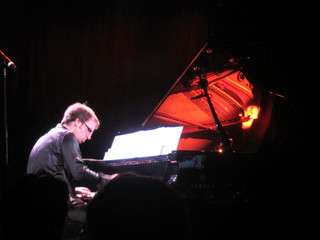|
Back
Liszt’s Cover Music of Beethoven New York
Le Poisson Rouge
09/17/2012 -
Ludwig van Beethoven: Symphonies Nr. 1 in C Major & Nr. 3 in E flat Major (“Eroica”) (Arranged for piano by Franz Liszt)
Gabriele Balducci (Pianist)

G. Balducci at Poisson Rouge (© Coco T. Dawg)
The inventor of “cover music” was J. S. Bach, who loved to arrange music of his contemporaries). But it was Franz Liszt who, in the era before recordings, broadcast his cover arrangements from friends and colleagues, actually using his fame to advertise their greatness.
If Europe was unable to hear a Wagner opera, Liszt turned his friend’s orchestral textures into virtuoso piano music. No tenor or soprano around? Franz Schubert was “sung” by Franz Liszt. Bellini, Verdi, even Tchaikovsky got the Liszt treatment, either as free paraphrase or direct translation.
But no transcriptions were more surprising that Liszt’s arrangements of Beethoven’s unpianistic symphonies. Ludwig, long deceased, didn’t need the advertising, yet Liszt’s love inspired two different arrangements of the all nine symphonies. Granted, he left the choral parts of the Ninth untranscribed (allowing a chorus to sing with the piano), but later, Cyprien Katsaris reworked the Liszt to encompass the entire work.
Liszt himself wrote a more melodic, more transparent, more playable second transcription late in his years. But the first arrangement–denser, more difficult, far more challenging–was what Italian pianist Gabriele Balducci chose to play for his New York debut concert.
And how fitting he chose Le Poisson Rouge for the two Beethoven symphonies. Audiences here select their concerts carefully in this eclectic playground, and Mr. Balducci, a modest anecdotalist, had them rapt with attention as he surveyed the First and Third symphonies without a break.
Mr. Balducci intends to record them all (one disc was on sale in the lobby), and I have little doubt that the recordings will be more careful than his concert last night. Not that these bountiful spectacular versions were played with slapdash fury. But yes, technical mistakes were many, as Mr. Balducci attempted perfection and came up wanting.
The Liszt works are theoretically impossible, because Beethoven was as much an experimenter with orchestras as Haydn, and the Hungarian composer couldn’t possibly have imitated the horns of the Eroica third movement or the colorful alteration of strings and winds, or the soaring cello music of the Third Symphony.
So it takes a very special pianist to survey the impossible. Mr. Balducci is an engaging pianist (as he showed in his encore). But his literal, frequently arduous playing was far from the free-flying eccentricities of Cyprien Katsaris or the sheer lyrical beauty of Leslie Howard. Not as exciting as Katsaris, but Howard can actually make the piano sound like a string section.
In the simpler moments, like the introduction of the First Symphony or the variations of the Eroica, Mr. Balducci showed a keyboard dexterity, and I would love to hear his concert of dedicated piano music. But here, Mr. Balducci tried all too hard, far too earnestly. The multi-textures of the music were on display, but one was more apt to think, “He really does make it sound like a Beethoven symphony”, rather than feeling what Liszt must have felt when he wrote these arrangements.
In a live performance, one shouldn’t really note the blurring of the fast movements or the less than accurate runs up the keyboard, concentrating on his more delicate movements of the slow movements, his mighty (if un-orchestral) fugue of the the Eroica. Yet I kept thinking, as he thumbed through the score on the keyboard, or conducted himself with one hand, or re-adjusted his glasses Clark Kent style, that there were too many distractions. He did his best, but–like actors who learn improvisation–when the “best” is blatantly showing, it’s better not to try so hard.
If the Beethoven wasn’t satisfactory, a little encore written for him by Giuseppe Lubis was pure delight. Based on Balducci’s name, on Schumann and on Spanish music, it was a short quodlibet including lots of 19th Century tunes, Iberian rhythms, and a mass of musical hints. Mr. Balducci played it with the sheer delight that was missing from his weightier section of the recital.
Harry Rolnick
|